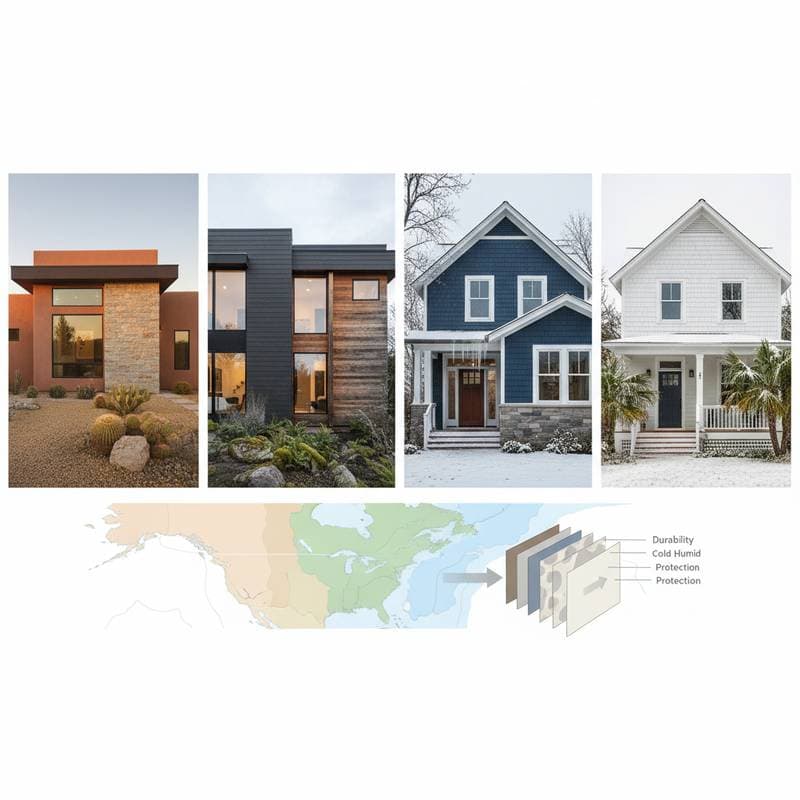Understanding Climate's Impact on Siding Choices
Selecting siding involves more than aesthetics. Local climate conditions, including temperature extremes, humidity levels, and wind patterns, directly influence material performance and lifespan. A siding type that endures for years in arid environments may deteriorate rapidly in humid or coastal areas. Homeowners benefit from evaluating these factors alongside building codes and personal maintenance preferences to achieve durable results.
Heat causes expansion and contraction, potentially leading to cracks if materials lack flexibility. Cold temperatures can make rigid sidings brittle, increasing fracture risks during freeze-thaw cycles. Moisture promotes mold growth and rot, while wind exerts pressure that tests fastening strength. By matching siding to these elements, owners avoid premature replacements and reduce long-term expenses.
Exploring Siding Styles and Profiles
Siding styles vary in design and functionality, each suited to specific climate demands. Understanding core profiles helps in selecting options that integrate seamlessly with regional weather challenges.
Key Siding Profiles
- Lap siding: This overlapping design excels in shedding water on structures with moderate roof slopes, making it versatile for many areas.
- Board and batten: Ideal for rural or mountainous settings, this profile requires precise sealing at joints to prevent water infiltration.
- Shingles or shakes: These textured options perform well in coastal or temperate zones when paired with drainage gaps to manage moisture.
- Panel systems: Common in contemporary builds, panels often feature concealed fasteners and rain screen assemblies for enhanced ventilation.
Proper profile selection ensures water runoff and air circulation, critical for preventing damage in varying climates.
Evaluating Material Options by Climate
Different materials respond uniquely to environmental stresses. The following table outlines pros, cons, and ideal climate matches to guide informed decisions.
| Material | Pros | Cons | Best Climate Fit |
|---|---|---|---|
| Vinyl | Affordable, lightweight, integrated color | Prone to cracking in severe cold, UV fading | Mild or arid regions |
| Fiber Cement | Fire-resistant, dimensionally stable, minimal expansion | Heavier weight, requires sealing on cut edges | Humid, coastal, or fire-prone areas |
| Engineered Wood | Authentic wood appearance, lighter than cement | Needs ongoing sealing, susceptible to water absorption | Temperate or dry climates |
| Metal | Non-combustible, resistant to pests | Transfers heat, vulnerable to dents from impacts | High-fire-risk or hail-exposed zones |
| Natural Wood | Timeless aesthetic, sustainable source | Demands regular repainting, attracts insects | Arid or cooler environments |
Vinyl suits budget-conscious projects in stable weather, while fiber cement withstands salt spray and high humidity near oceans. Engineered wood offers a natural look with improved resistance when properly maintained. Metal provides robust protection in stormy or wildfire areas, and natural wood thrives where dryness limits decay.
Strategies for Combining Materials
Combining siding types creates visually dynamic facades when planned carefully. Align material weights to avoid uneven settling, and synchronize maintenance schedules to simplify upkeep. Position the most resilient material on lower walls exposed to ground moisture, reserving accents for upper sections or gables.
Compatibility in thermal expansion rates prevents stress at joints, reducing cracks over time. Test combinations through small-scale applications to confirm harmony in color and texture under local lighting.
Selecting Trim and Accents
Trim protects edges and frames windows or doors, enhancing both function and style. In moisture-heavy regions, opt for factory-primed or PVC variants that resist warping. Hot, dry climates favor painted wood or fiber cement for durability without excessive cracking.
Install flashing behind all trim to direct water away from vulnerable areas. This step safeguards against leaks and extends the overall system's integrity.
Real-World Application Examples
Practical scenarios illustrate effective choices.
- Coastal residence: Install fiber cement lap siding using stainless steel fasteners and a breathable house wrap to combat corrosion and humidity.
- Mountain retreat: Apply board and batten engineered wood with back-primed boards and additional venting to handle temperature fluctuations and snow loads.
- Urban renovation: Use metal panels over continuous insulation to improve energy efficiency and meet fire safety standards in dense settings.
These examples demonstrate how tailored selections address specific risks while meeting aesthetic goals.
Preparing for a Siding Installation Project
Thorough preparation ensures a smooth process and high-quality outcome. Follow these steps to align the project with climate realities.
1. Establish Project Objectives
Define priorities such as enhanced insulation, reduced maintenance, or elevated visual appeal. Research materials that fulfill these aims within local weather constraints, consulting manufacturer guidelines for climate compatibility.
2. Identify Qualified Contractors
Obtain bids from at least three licensed professionals experienced in regional conditions. Review their portfolios for evidence of sound flashing and trim work. Inquire about their approaches to moisture management and adherence to local codes.
3. Review Samples and Create Mockups
Examine full-scale samples under site-specific lighting to assess color and finish variations. For multi-material designs, construct a test panel to evaluate integration and avoid on-site disagreements.
4. Prepare the Site
Secure clear pathways for equipment, prune overhanging vegetation, and relocate delicate features. Plan for debris removal and provide electrical access for power tools. Protect interiors by covering windows and outdoor surfaces against dust.
5. Monitor Installation Progress
Expect installers to assess sheathing integrity prior to wrapping and document moisture levels. Confirm that fasteners follow specified intervals from manufacturers. Capture progress photos at each phase to track compliance and resolve issues promptly.
Maintaining Siding for Enduring Performance
Climate-appropriate siding demands consistent care to maximize lifespan and preserve warranties. Regular inspections reveal early signs of wear, such as loose fasteners or discoloration, allowing timely interventions. Clean surfaces gently to remove debris, and address drainage issues to prevent water pooling.
Seasonal touch-ups, like resealing joints or repainting exposed areas, sustain protective barriers against elements. These practices not only uphold appearance but also support energy efficiency by maintaining the home's thermal envelope. Homeowners who invest in matched materials and proactive maintenance enjoy reliable protection and aesthetic appeal for decades.

